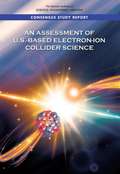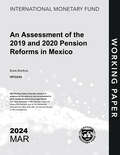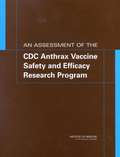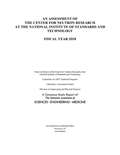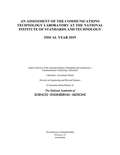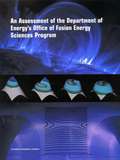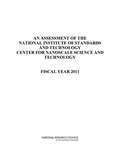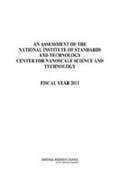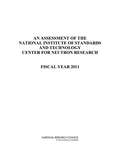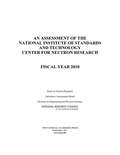- Table View
- List View
An Assessment of Selected Divisions of the Physical Measurement Laboratory at the National Institute of Standards and Technology: Fiscal Year 2021
by Division on Engineering and Physical Sciences Laboratory Assessments Board National Academies of Sciences, Engineering, and Medicine Committee on NIST Technical Programs Panel on Assessment of Selected Divisions of the Physical Measurement Laboratory at the National Institute of Standards and TechnologyAt the request of the National Institute of Standards and Technology (NIST), the National Academies of Sciences, Engineering, and Medicine has, since 1959, annually assembled panels of experts from academia, industry, medicine, and other scientific and engineering environments to assess the quality and effectiveness of the NIST measurements and standards laboratories, as well as the adequacy of the laboratories' resources. This report assesses the scientific and technical work performed by the NIST Physical Measurement Laboratory in the Quantum Measurement Division, Radiation Physics Division, Sensor Science Division, Microsystems and Nanotechnology Division, and Nanoscale Device Characterization Division.
An Assessment of Selected Programs at the National Institute of Standards and Technology Engineering Laboratory: Fiscal Year 2020
by Division on Engineering and Physical Sciences Laboratory Assessments Board National Academies of Sciences, Engineering, and Medicine Committee on NIST Technical Programs Panel on Review of the Engineering Laboratory at the National Institute of Standards and TechnologyNational Institute of Standards and Technology (NIST) Engineering Laboratory has a long and distinguished record of technological leadership, innovation, and experience in providing analysis and solutions to large and small problems. Engineering Laboratory research quality is exemplified by the programs’ science-based tools and outputs. This report assesses the scientific and technical work performed by the NIST Engineering Laboratory and presents findings, conclusions, and recommendations to advance the mission and vision of NIST with a focus on strategic thinking and planning to support long-term efforts.
An Assessment of Selected Research Programs and Goals of the Engineering Laboratory at the National Institute of Standards and Technology: Fiscal Year 2024
by Division on Engineering and Physical Sciences Laboratory Assessments Board National Academies of Sciences, Engineering, and Medicine Panel on Assessment of the National Institute of Standards and Technology (NIST) Engineering LaboratorySince 1959, the National Institute of Standards and Technology (NIST) has engaged the National Academies of Sciences, Engineering, and Medicine annually to assess the quality, effectiveness, and resource adequacy of NIST’s six measurement and standards laboratories. This report reviews the NIST Engineering Laboratory (EL), evaluating technical programs, assessing EL’s portfolio of scientific and technical expertise, reviewing the adequacy of facilities, equipment, and human resources, and evaluating EL’s effectiveness in disseminating its program outputs.
An Assessment of U.S.-Based Electron-Ion Collider Science
by Engineering Medicine National Academies of SciencesUnderstanding of protons and neutrons, or “nucleons”—the building blocks of atomic nuclei—has advanced dramatically, both theoretically and experimentally, in the past half century. A central goal of modern nuclear physics is to understand the structure of the proton and neutron directly from the dynamics of their quarks and gluons governed by the theory of their interactions, quantum chromodynamics (QCD), and how nuclear interactions between protons and neutrons emerge from these dynamics. With deeper understanding of the quark-gluon structure of matter, scientists are poised to reach a deeper picture of these building blocks, and atomic nuclei themselves, as collective many-body systems with new emergent behavior. The development of a U.S. domestic electron-ion collider (EIC) facility has the potential to answer questions that are central to completing an understanding of atoms and integral to the agenda of nuclear physics today. This study assesses the merits and significance of the science that could be addressed by an EIC, and its importance to nuclear physics in particular and to the physical sciences in general. It evaluates the significance of the science that would be enabled by the construction of an EIC, its benefits to U.S. leadership in nuclear physics, and the benefits to other fields of science of a U.S.-based EIC.
An Assessment of Undersea Weapons Science and Technology
by Technology Committee for Undersea Weapons ScienceAn Assessment of Undersea Weapons Science and Technology
An Assessment of the 2019 and 2020 Pension Reforms in Mexico (Imf Working Papers)
by BonthuisA report from the International Monetary Fund.
An Assessment of the CDC Anthrax Vaccine Safety and Efficacy Research Program
by Committee to Review the CDC Anthrax Vaccine Safety Efficacy Research ProgramIn 1998, the Department of Defense (DoD) began a program of mandatory immunization against anthrax for all military personnel. As the program proceeded, however, some military personnel and their families raised concerns about the safety and efficacy of the anthrax vaccine. Acknowledging both the need to protect military personnel and the concerns about the anthrax vaccine, Congress directed the Centers for Disease Control and Prevention (CDC) to carry out a research program on its safety and efficacy. To assist in the development of this program, CDC requested the Institute of Medicine to convene a committee to review the completeness and appropriateness of the research program. "In An Assessment of the CDC Anthrax Vaccine Safety and Efficacy Research Program, the committee makes an overall assessment of the CDC research plan and reviews the specific studies proposed by CDC in the three areas of efficacy, safety, and acceptability. The committee also notes additional research needs that became evident following the bioterrorist events of 2001 and makes recommendations about the leadership of the research program.
An Assessment of the Center for Neutron Research at the National Institute of Standards and Technology: Fiscal Year 2018
by Engineering Medicine National Academies of SciencesAt the request of the National Institute of Standards and Technology (NIST), the National Academies of Sciences, Engineering, and Medicine has, since 1959 annually assembled panels of experts from academia, industry, medicine, and other scientific and engineering environments to assess the quality and effectiveness of the NIST measurements and standards laboratories, of which there are now seven, as well as the adequacy of the laboratories’ resources. This report assesses the scientific and technical work performed by the National Institute of Standards and Technology (NIST) Center for Neutron Research in the fiscal year 2018. It reviews the organization's technical programs; the portfolio of scientific expertise within the organization; the adequacy of the organization's facilities, equipment, and human resources; and the effectiveness with which the organization disseminates its program outputs.
An Assessment of the Center for Neutron Research at the National Institute of Standards and Technology: Fiscal Year 2021
by Division on Engineering and Physical Sciences Laboratory Assessments Board National Academies of Sciences, Engineering, and Medicine Panel on Assessment of the Center for Neutron Research at the National Institute of StandardsAt the request of the National Institute of Standards and Technology (NIST), the National Academies of Sciences, Engineering, and Medicine has, since 1959, annually assembled panels of experts from academia, industry, medicine, and other scientific and engineering communities to assess the quality and effectiveness of the NIST measurements and standards laboratories. The NIST Center for Neutron Research (NCNR) is one of six major research organizational units consisting of five laboratories and one user facility at NIST. It is one of only three neutron scattering user facilities in the United States, with 30 instruments, supporting roughly one-third of the U.S. neutron scattering instruments and users. This report assesses the scientific and technical work performed by the NCNR, as well as the portfolio of scientific expertise within the organization and dissemination of program outputs.
An Assessment of the Communications Technology Laboratory at the National Institute of Standards and Technology: Fiscal Year 2019
by Engineering Medicine National Academies of SciencesAn Assessment of the Communications Technology Laboratory at the National Institute of Standards and Technology: Fiscal Year 2019 is an independent technical assessment of the quality of the National Institute of Standards and Technology's (NIST's) Communications Technology Laboratory (CTL). It reviews the organization's technical programs, the portfolio of scientific expertise within the organization, the adequacy of the organization's facilities, equipment, and human resources, and the effectiveness by which the organization disseminates its program outputs. This report focuses on CTL priority areas such as public safety communications, trusted spectrum testing, and Next Generation Wireless (5G and Beyond). It also assesses the extent to which CTL applied the recommendations from a 2015 National Academies' report, which describes many of the critical uses of radio communications, provides lab-specific recommendations, and highlights important research priorities for the Boulder, Colorado communications technology laboratory of the Department of Commerce laboratory. This new report also describes the current activities of the Boulder telecommunications laboratories, its strengths and weaknesses as an organization, and its plans for the near future
An Assessment of the Department of Energy's Office of Fusion Energy Sciences Program
by National Research CouncilThe National Academies Press (NAP)--publisher for the National Academies--publishes more than 200 books a year offering the most authoritative views, definitive information, and groundbreaking recommendations on a wide range of topics in science, engineering, and health. Our books are unique in that they are authored by the nation's leading experts in every scientific field.
An Assessment of the Divisions of the Physical Measurement Laboratory at the National Institute of Standards and Technology Located in Boulder, Colorado: Fiscal Year 2023
by Division on Engineering and Physical Sciences Laboratory Assessments Board National Academies of Sciences, Engineering, and Medicine Panel on the Assessment of the National Institute of Standards and Technology (NIST) Physical Measurement LaboratorySince 1959, the National Institute of Standards and Technology (NIST) has annually commissioned the National Academies of Sciences, Engineering, and Medicine to assess its various measurements and standards laboratories. This report appraises the Physical Measurement Laboratory (PML), assessing four divisions of PML situated at the NIST Boulder campus: the Applied Physics Division, the Time and Frequency Division, the Quantum Electromagnetics Division, and the Quantum Physics Division. The report compares the caliber of research at PML with similar international programs to determine whether programs adequately align with its objectives; assesses the range of scientific and technical expertise available within PML; considers the budget, facilities, equipment, and Human Resources to bolster PML technical endeavors and contribute to the fulfillment of its goals; and assesses the efficacy of PML methods for disseminating the products of its work.
An Assessment of the Global Impact of the Financial Crisis
by Philip Arestis Rogéo Sobreira Joséuis OreiroThis topical volume analyzes the impact of the 2008 financial crisis. It considers the origins and explanations of the current crisis, examines the regulatory implications and, with specific focus on developing countries, it provides a strategy for economic growth that can guarantee financial stability in the future.
An Assessment of the International Science and Technology Center: Redirecting Expertise in Weapons of Mass Destruction in the Former Soviet Union
by Office of International AffairsThis report reviews the ISTC's objectives and plans, discussed its activities with U.S. and FSU officials, and met with FSU grant recipients and institute directors. The committee concludes that during its first two years the ISTC was successful and effective in meeting its primary objective, which, in turn, has contributed to the larger goal of diminishing the risk of weapons proliferation. Moreover, the opportunities provided to FSU scientists and engineers do indeed offer meaningful nonweapons-related work, which helps address the demoralization that may otherwise contribute to scientists' being lured into work for unfriendly governments. The committee believes the ISTC has also been successful in addressing its secondary objectives—namely, the solution of national and international technical problems; the support of basic and applied research and technology development for peaceful purposes; and, to a lesser degree, reinforcement of the transition of the FSU to a market-driven economy.
An Assessment of the Material Measurement Laboratory at the National Institute of Standards and Technology: Fiscal Year 2020
by Division on Engineering and Physical Sciences Laboratory Assessments Board National Academies of Sciences, Engineering, and Medicine Panel on Review of the Material Measurement Laboratory at the National Institute of Standards and TechnologyThe Material Measurement Laboratory (MML) of the National Institute of Standards and Technology (NIST) comprises six technical divisions and two offices. The two offices manage programs related to NIST standard reference materials and NIST data products or standard reference data. The technical divisions engage in research and development of the measurement science, standards, technology, and data required to support the nation’s need to design, develop, manufacture, and use materials. These divisions interact extensively with both industry and public institutions to advance the economy and provide tools for the creation of knowledge. This report assesses the scientific and technical work performed by the NIST Material Measurement Laboratory and makes actionable recommendations to support MML in the achievement of its objectives.
An Assessment of the Material Measurement Laboratory at the National Institute of Standards and Technology: Fiscal Year 2023
by Division on Engineering and Physical Sciences Laboratory Assessments Board National Academies of Sciences, Engineering, and Medicine Panel on the Assessment of the National Institute of Standards and Technology (NIST) Material Measurement LaboratorySince 1959, the National Institute of Standards and Technology (NIST) has annually engaged the National Academies of Sciences, Engineering, and Medicine to assemble panels of experts to assess the quality and effectiveness of the NIST measurements and standards laboratories as well as the adequacy of the laboratory resources. This report assesses the Material Measurement Laboratory (MML), with a focus on technical programs, quality of research, scientific and technical expertise, dissemination products and strategies, and how well budget, facilities, equipment, and human resources support technical programs and MML objectives.
An Assessment of the National Institute of Standards and Technology Building and Fire Research Laboratory: Fiscal Year 2010
by National Research Council of the National AcademiesA panel of experts appointed by the National Research Council assessed the scientific and technical work of the Building and Fire Research Laboratory (BFRL) of the National Institute of Standards and Technology (NIST). The scope of the assessment included the following criteria: (1) the technical merit of the current laboratory programs relative to the current state of the art worldwide; (2) the adequacy of the laboratory facilities, equipment, and human resources, as they affect the quality of the laboratory technical programs; and (3) the degree to which the laboratory programs in measurement science and standards achieve their stated objectives and desired impact.
An Assessment of the National Institute of Standards and Technology Center for Nanoscale Science and Technology
by The National Academy of SciencesSince 1959, the National Research Council (NRC), at the request of the National Institute of Standards and Technology (NIST), has annually assembled panels of experts to assess the quality and effectiveness of the NIST measurements and standards laboratories. In 2011, the NRC evaluated three of the six NIST laboratories: the Center for Nanoscale Science and Technology (CNST), the NIST Center for Neutron Research (NCNR) and the Information Technology Laboratory (ITL). Each of these was addressed individually by a separate panel of experts; this report assesses CNST.
An Assessment of the National Institute of Standards and Technology Center for Nanoscale Science and Technology: Fiscal Year 2011
by Technology Panel on Nanoscale ScienceSince 1959, the National Research Council (NRC), at the request of the National Institute of Standards and Technology (NIST), has annually assembled panels of experts to assess the quality and effectiveness of the NIST measurements and standards laboratories. In 2011, the NRC evaluated three of the six NIST laboratories: the Center for Nanoscale Science and Technology (CNST), the NIST Center for Neutron Research (NCNR) and the Information Technology Laboratory (ITL). Each of these was addressed individually by a separate panel of experts; this report assesses CNST.
An Assessment of the National Institute of Standards and Technology Center for Neutron Research
by National Research Council Panel on Neutron ResearchThe National Institute of Standards and Technology [NIST] Center for Neutron Research (NCNR) is a national user facility whose mission is to ensure the availability of neutron measurement capabilities in order to meet the needs of U.S. researchers from industry, academia, and government agencies.<P><P> This mission is aligned with the mission of NIST, which is to promote U.S. innovation and industrial competitiveness by advancing measurement science, standards, and technology in ways that enhance economic security and improve the quality of life.
An Assessment of the National Institute of Standards and Technology Center for Neutron Research
by The National Academy of SciencesSince 1959, the National Research Council (NRC), at the request of the National Institute of Standards and Technology (NIST), has annually assembled panels of experts to assess the quality and effectiveness of the NIST measurements and standards laboratories. In 2011, the NRC evaluated three of the six NIST laboratories: the Center for Nanoscale Science and Technology (CNST), the NIST Center for Neutron Research (NCNR) and the Information Technology Laboratory (ITL). Each of these was addressed individually by a separate panel of experts; this report assesses NCNR.
An Assessment of the National Institute of Standards and Technology Center for Neutron Research: Fiscal Year 2010
by National Research Council of the National AcademiesThe National Institute of Standards and Technology (NIST) Center for Neutron Research (NCNR) is a national user facility whose mission is to ensure the availability of neutron measurement capabilities in order to meet the needs of U.S. researchers from industry, academia, and government agencies. This mission is aligned with the mission of NIST, which is to promote U.S. innovation and industrial competitiveness by advancing measurement science, standards, and technology in ways that enhance economic security and improve the quality of life. As requested by the Deputy Director of NIST, this book assesses NCNR, based on the following criteria: (1) the technical merit of the current laboratory programs relative to current state-of-the-art programs worldwide; (2) the adequacy of the laboratory budget, facilities, equipment, and human resources, as they affect the quality of the laboratory technical programs; and (3) the degree to which the laboratory programs in measurement science and standards achieve their stated objectives and desired impact.
An Assessment of the National Institute of Standards and Technology Center for Neutron Research: Fiscal Year 2013
by National Research Council of the National AcademiesThe National Institute of Standards and Technology (NIST) Center for Neutron Research (NCNR), with its strong tradition of hiring and developing excellent scientific and technical staff, is one of the leading institutions worldwide in neutron instrumentation, technology, and science. It is a very well-managed user facility. With the recent completion of a $95 million expansion, performed on time and on budget, it has enhanced its instrumentation capabilities and has constructed a new guide hall. This expansion further enhances NCNR’s ability to meet high user demands—a factor of two higher than capacity—for experimentation to conduct cutting-edge research. NCNR’s high scientific productivity is due, in part, to effective communication between the management and staff and with the internal and external user communities. <P> To continue to respond effectively to a changing environment and opportunities afforded by the recent reorganization of NIST, the NCNR management should pay particular attention to the considerations below to ensure that the NCNR continues to effectively serve its mission. <P><P> NCNR management has historically done an excellent job at short-term, tactical planning. The NIST reorganization now provides them with an opportunity to operate more strategically. Because in the near future some of the more senior scientific and technical staff will be retiring, formalized succession planning needs to be performed in coordination with the broader NIST management.
An Assessment of the National Institute of Standards and Technology Center for Neutron Research: Fiscal Year 2023
by Division on Engineering and Physical Sciences Laboratory Assessments Board National Academies of Sciences, Engineering, and Medicine Panel on the Assessment of the National Institute of Standards and Technology (NIST) Center for Neutron ResearchSince 1959, the National Institute of Standards and Technology (NIST) has annually enlisted the National Academies of Sciences, Engineering, and Medicine to convene expert panels comprising individuals from academia, industry, and various scientific and engineering fields. Their primary task is to evaluate the quality and efficacy of the six NIST measurements and standards laboratories, as well as the sufficiency of resources available to these laboratories. This report assesses the NIST Center for Neutron Research (NCNR), with a focus on scientific and technical programs; portfolio of scientific and technical expertise; the adequacy of the budget, facilities, instrumentation, and human resources; and the effectiveness of NCNR dissemination efforts.
An Assessment of the National Institute of Standards and Technology Engineering Laboratory: Fiscal Year 2014
by Technology Panel on Review of the Engineering Laboratory at the National Institute of StandardsThe mission of the Engineering Laboratory of the National Institute of Standards and Technology (NIST) is to promote U. S. innovation and industrial competitiveness through measurement science and standards for technology-intensive manufacturing, construction, and cyberphysical systems in ways that enhance economic prosperity and improve the quality of life. To support this mission, the Engineering Laboratory has developed thrusts in smart manufacturing, construction, and cyberphysical systems; in sustainable and energy-efficient manufacturing materials and infrastructure; and in disaster-resilient buildings, infrastructure, and communities. The technical work of the Engineering Laboratory is performed in five divisions: Intelligent Systems; Materials and Structural Systems; Energy and Environment; Systems Integration; and Fire Research; and two offices: Applied Economics Office and Smart Grid Program Office. An Assessment of the National Institute of Standards and Technology Engineering Laboratory Fiscal Year 2014 assesses the scientific and technical work performed by the NIST Engineering Laboratory. This report evaluates the organization's technical programs, portfolio of scientific expertise within the organization, adequacy of the organization's facilities, equipment, and human resources, and the effectiveness by which the organization disseminates its program outputs.

